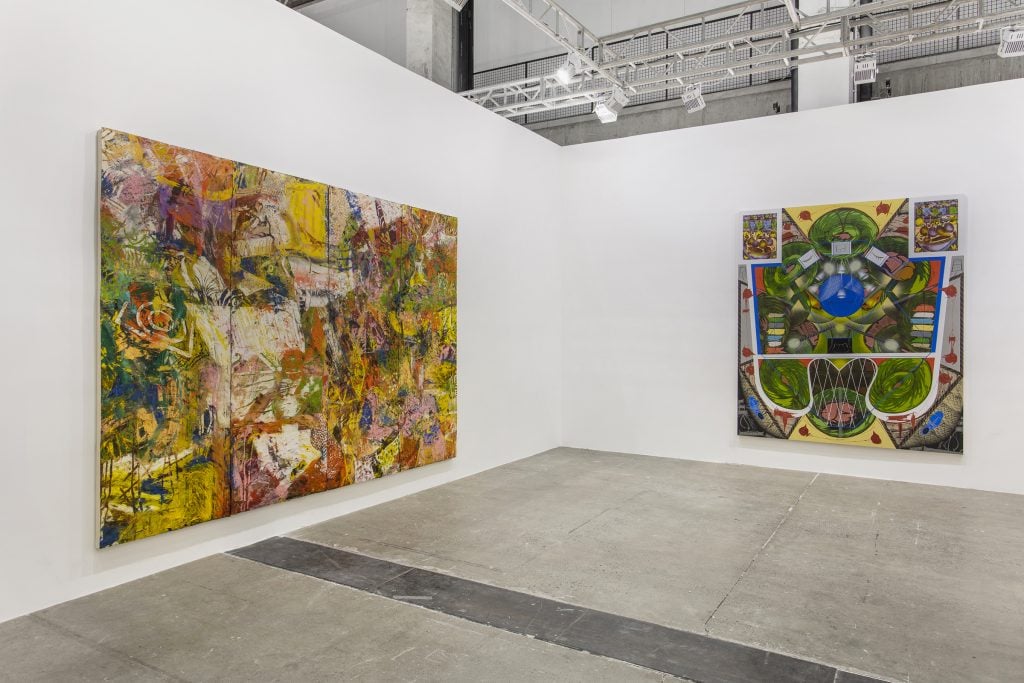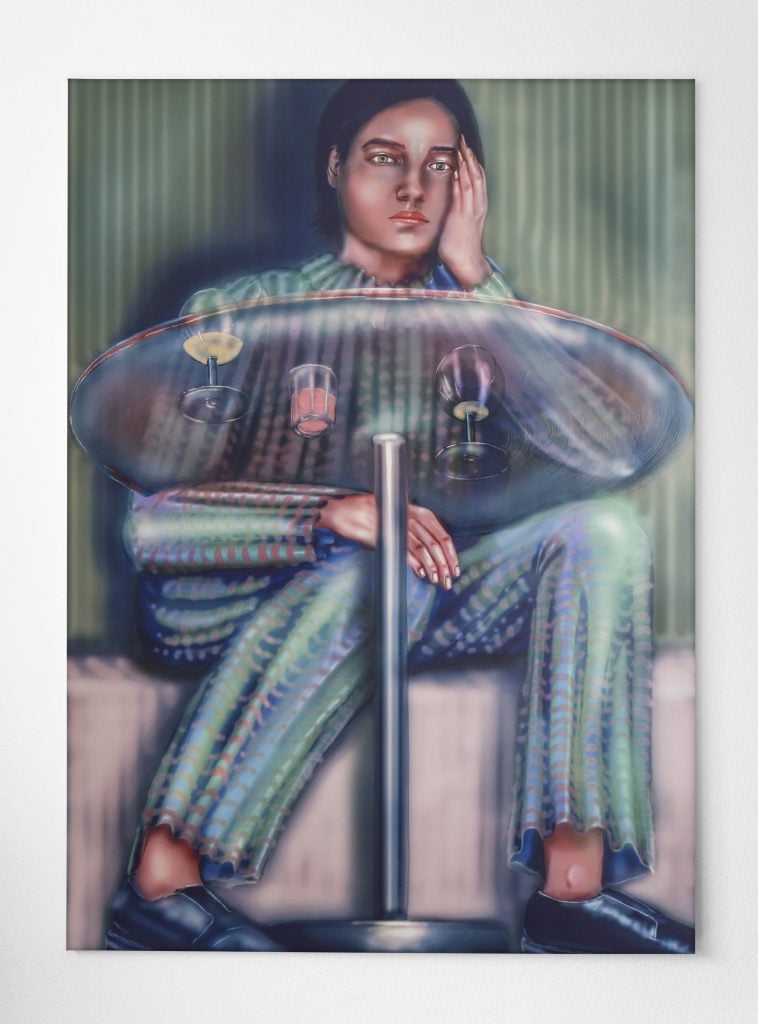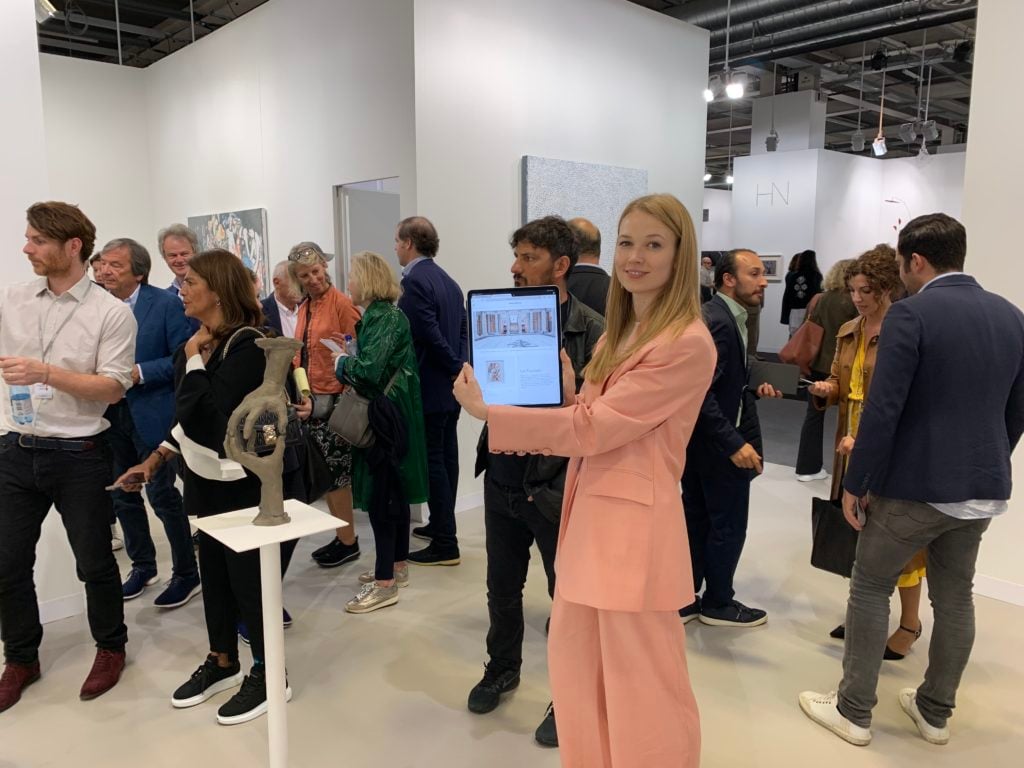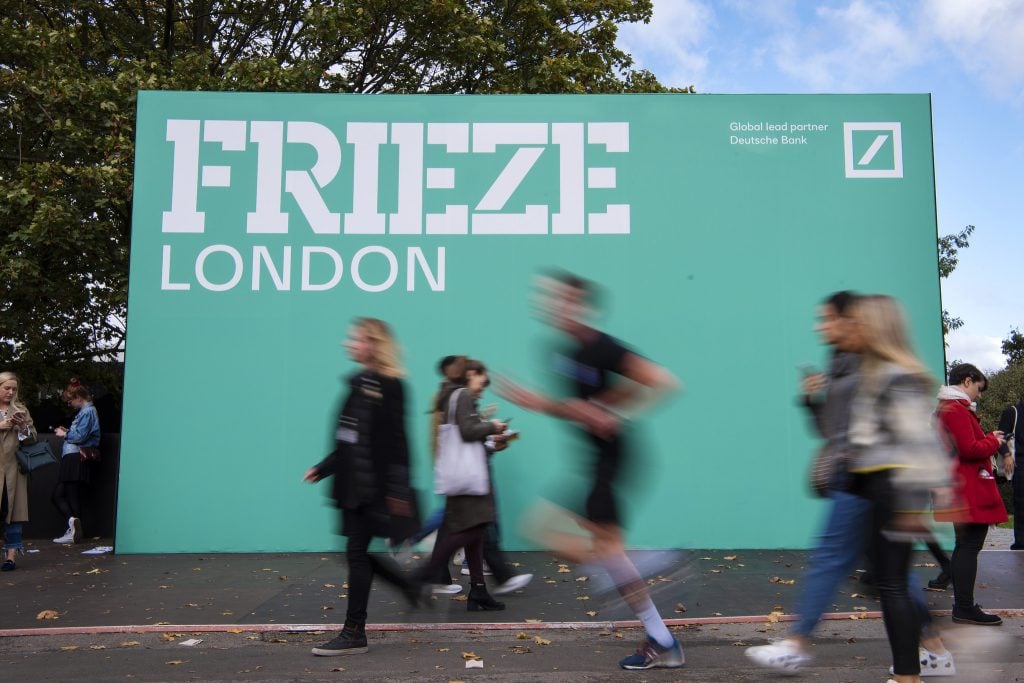For nearly a year, art dealers unable to travel the art-fair circuit have taken up the many online viewing rooms (or OVRs for short) that Art Basel, Frieze, and other fairs have made available.
OVRs have certain advantages: collectors like the price transparency many fairs have demanded, and gallerists enjoy saving money on costly flights, hotels, and dinners. On the downside, the novelty of the online fair wears off quickly given the relative lack of excitement that accompanies staring at a screen.
We asked more than a dozen art dealers, from small to midsize to mega, about what they liked—and didn’t—during this year of OVRs. Here’s what we learned.

1-54 Contemporary African Art Fair in London. Photo by Rocio Chacon.
1. It May Not Be “Real,” But the Client Engagement Is
Javier Peres, founder of Peres Projects and a regular at fairs such as FIAC and Frieze, said he was ready to try out new fair models in the pandemic era because fairs have always been essential to his business.
“The speed at which the art fairs came up with [OVRs] was pretty amazing, and it was a big support to all of us,” he said. “Let’s be real—we are just pretending there is an art fair happening. But it gave us an opportunity to engage with people.”
Though Peres has yet to meet many of his new clients—some of whom, he said, have become “hugely important”—he has had “long exchanges, to the point now that we are leaving audio voice messages—maybe this is the way it is going.”
Other dealers echoed Peres. Daniel Roesler, co-owner of Galeria Nara Roesler, noted that he was able to connect with clients who might not have traveled to a particular physical fair.
Meanwhile, some dealers took the year to develop a targeted geographic strategy. Focusing on cultivating new clients in Asia, Thaddaeus Ropac said the Art Busan and Taipei Dangdai fairs were “particularly successful” and “a good indicator of collectors’ appetite for buying at that time in the pandemic and the growth of our network in Asia.”

Austin Lee and Ad Minolti’s works on view at Peres Projects’s booth at Art Busan & Design 2020. Courtesy Peres Projects, Berlin.
2. Price Transparency Was a Game-Changer and Collectors Didn’t Quibble (Too Much)
Art Basel organizers made the decision to post prices alongside works in OVRs out of the gate. And not only were dealers cooperative, but collectors were enthusiastic about the idea.
Several veteran art advisors and appraisers noted the intimidation factor that even uber-wealthy collectors experience when it comes to fine-art buying. Publicly posted prices help topple those barriers.
Dealers on the whole noted that collectors did not demand steep discounts, and that works typically sold at or near their asking points. Emma Son, senior director at Lehmann Maupin, said that 2020 “confirmed that there is a growing comfort to transact at a high price point. It is not only prints and photographs that are performing well on these platforms.”
The gallery sold a historical painting by Cecilia Vicuña priced at $375,000 through an Art Basel Hong Kong OVR to a young collector in Asia who had never seen the work in person.
“I kept the same prices as before,” said Irina Protopopescu, owner of the New York-based Slag Gallery. The highest price of a work she sold via OVR was $25,000.

West Bund Art & Design 2020. Booth view, Lehmann Maupin. Photo: JJYPHOTO
Courtesy Lehmann Maupin, New York, Hong Kong, Seoul, and London.
3. Dealers Realized They Didn’t Need to Be Doing So Many Fairs
The biggest surprise of the year may have been that dealers didn’t do as badly as they feared. There may have been fewer sales, but there were also lower booth costs and no dinners or travel to pay for. “I think the biggest shock going back to art fairs—which I am dying to do—will be all the expenses surrounding them,” Peres said.
“We participated in Art Busan, West Bund, and Hong Kong Spotlight, and our takeaway from these fairs is that there is still an enormous demand for art and the fair experience, even without the buzz of dinners and events,” said dealer David Maupin. His gallery will continue to focus on regional fairs in 2021, he said.
London’s Kate MacGarry was surprised by how many sales the gallery closed online in 2020. And in part because of that, she’ll stick with fewer fairs and less travel moving forward.
“I can see over the years that my sales at fairs versus the gallery are falling,” she said. “The idea of shipping works across the globe for a few days and possibly sell to someone from London is unsustainable.”
A local turn will inevitably mean a renewed emphasis on in-gallery programming. “With the opening of our new location in Chelsea this past January, the focus in 2021 will be on the physical exhibitions at the gallery,” Roesler said.
But many smaller galleries that are farther afield will tread carefully in the short term.
“No one can guarantee what the form of the fair will be,” said Warsaw-based dealer Dawid Radziszewski. That can be particularly concerning for artists. “They are very understanding under the circumstances, but we still don’t feel 100 percent comfortable engaging them in endeavors that might never ‘happen’ in real life.”

Louisa Gagliardi Absent-minded (2020). Courtesy Dawid Radziszewski Gallery.
4. Every Gallery’s Digital Strategy Is Its Own Secret Sauce
Without the distraction and expense of doing so many far-flung fairs, many gallerists focused on maximizing their OVRs. Son said Lehmann Maupin enjoyed TEFAF Online’s approach of spotlighting one work or body of work per gallery. (They chose Teresita Fernández’s 2008 Untitled (Fence).)
Other dealers realized the importance of contextual information. Mary Sabbatino of Galerie Lelong says her gallery had more success “when we realized we needed to provide more exciting content in the form of videos or talks.”
Others are taking advantage of established social networks.
“For us online sales are still strongly connected to Instagram,” Radziszewski said. Fairs have their own audience, but “Instagram has a great interface—and many smaller virtual fairs lack that. Plus, Instagram is less expensive to run.”
On the opposite end of the spectrum, some galleries have used the OVR platform for experimentation beyond IRL presentations.
“Since there were no physical limitations on the type of art we could present, at Pace we decided to dream big and mount the kind of wildly ambitious art-fair presentations that would never have been possible in the real world,” said Amelia Redgrift, senior director of global communications and content at Pace.
For Art Basel in Switzerland last June, the gallery presented an exhibition of monumental outdoor sculptures. That online viewing room received upwards of 5,000 visitors on preview days.
Elena Soboleva, director of online sales at David Zwirner, said that while online fairs offer an opportunity for collectors to think about buying and for the gallery to follow up, “it’s actually our website that drives the overwhelming majority of sales, inquiries, and engagement. We have seen sales ranging from multimillion [dollars] to under $10,000.”

David Zwirner Online Sales Director Elena Soboleva with her iPad at the gallery’s Art Basel booth back in 2019. Photo by Andrew Goldstein.
5. The Law of Diminishing Returns (Or, Why IRL Needs a Comeback)
MacGarry said the initial rush of enthusiasm has been “greatly reduced” since the first lockdown, adding that OVRs were a “novelty.”
“I am also tired of too much time online,” she said.
Soboleva echoed the sentiment: “In a strange way, we all miss art fairs. They were key social moments—in fact, I met my husband at one almost seven years ago.”
Art Basel seems to have recognized that, offering dealers unwilling or unable to travel to Hong Kong this year the option of what we like to call a “ghost booth,” which involves “a small curated exhibition within a standalone booth” to be staffed by assistants hired by Art Basel.
“We hope that this satellite option allows exhibitors to continue their onsite presence without physically attending the show,” the fair told dealers. (There is a catch, though: exhibitors must ensure that a sales representative remains on call at all times during the show’s opening hours.)
That points to a world beyond online sales, in which in-person events are back on the calendar. So what’s the legacy of OVRs?
“An OVR can’t take the place of the serendipity and personal contact as an in-person fair,” Sabbatino said. “But in the depths of the pandemic, it was useful to have a time-based tool to secure works from artists and reach out to our clients.”












